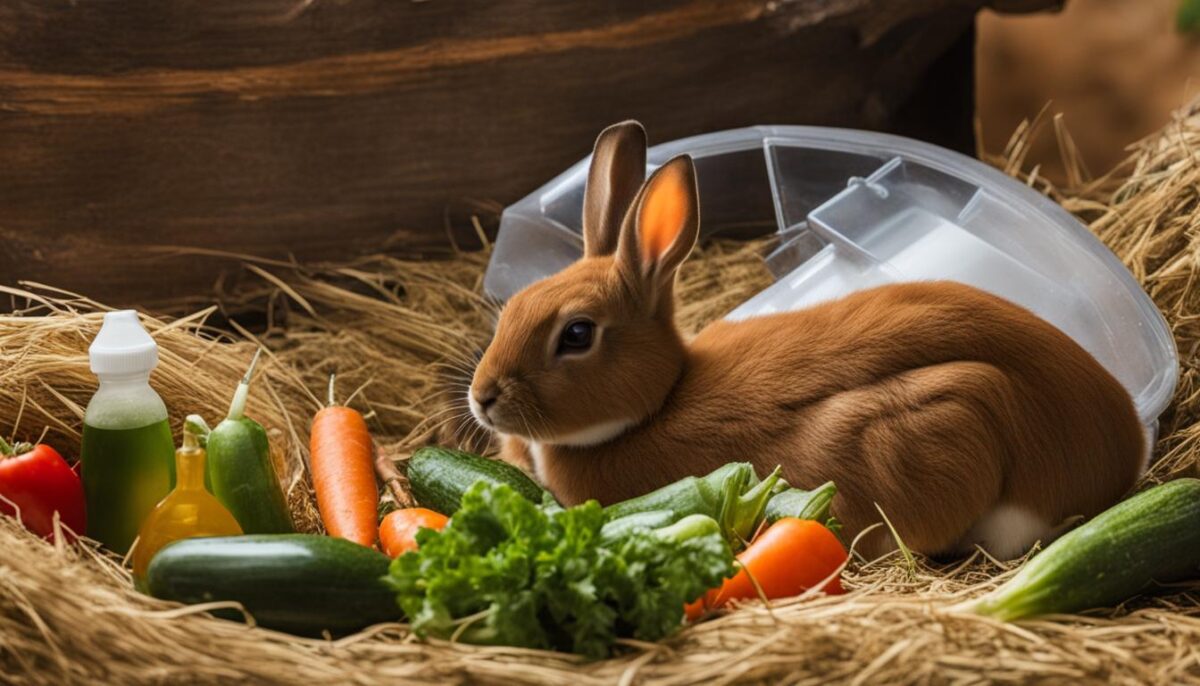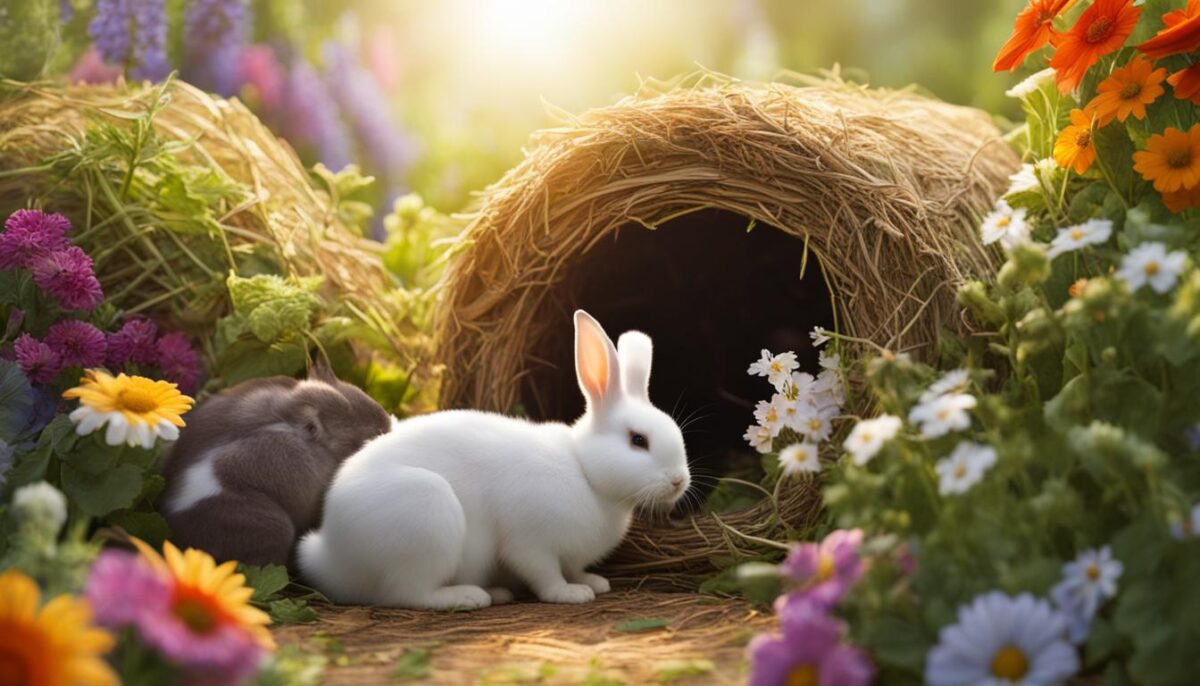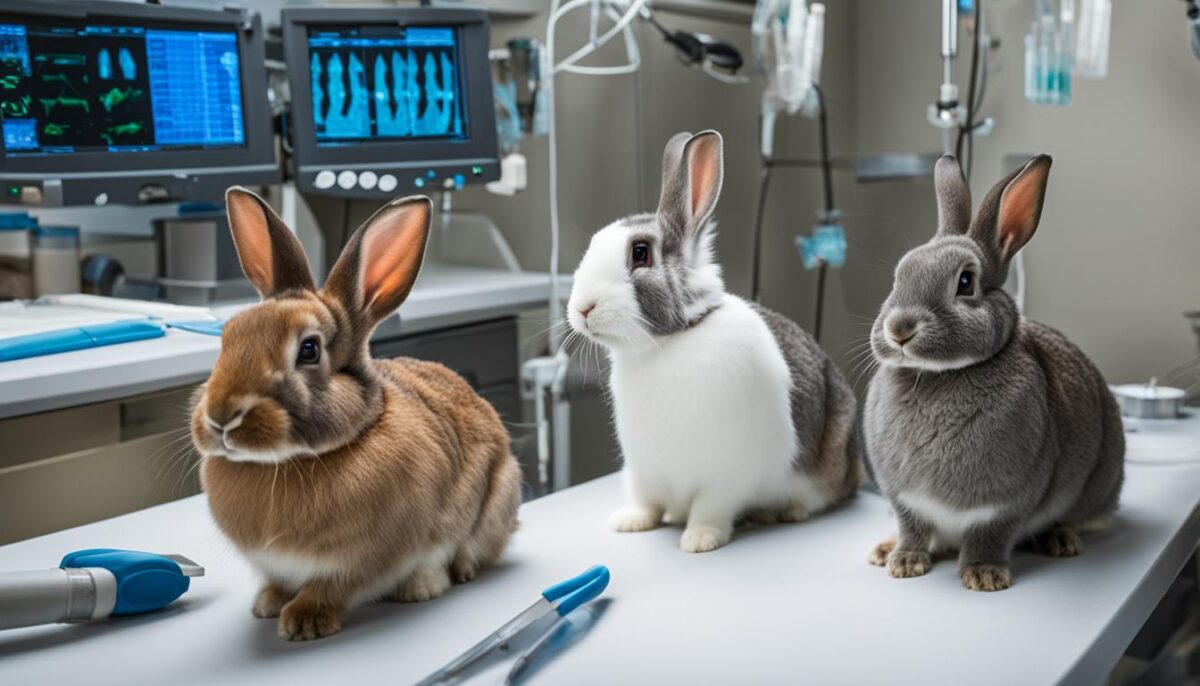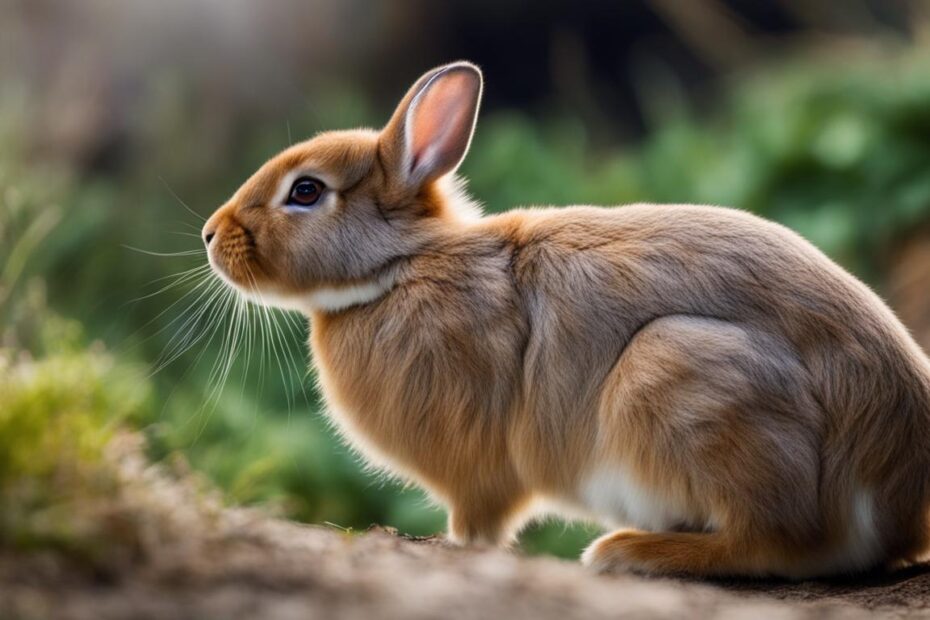Are you a rabbit owner or considering getting a rabbit as a pet? Understanding the signs of labor in rabbits is essential for providing proper care and support during this crucial time. Whether you’re a first-time owner or a seasoned rabbit enthusiast, knowing the pregnancy symptoms and labor signs in rabbits can help ensure a healthy and stress-free birthing experience for your furry friend.
Rabbits are typically able to become pregnant when they are 12 weeks old and can conceive at any time of the year. It’s important to be aware of the signs of pregnancy in rabbits, which include nesting behavior, fur pulling, and even aggressive behavior. If you suspect that your rabbit may be pregnant, it is highly recommended to take her to a veterinarian for confirmation and to discuss proper care during pregnancy and labor.
Key Takeaways:
- Recognizing signs of labor in rabbits is crucial for providing proper care.
- Pregnancy symptoms in rabbits include nest building, fur pulling, and aggression.
- Consult with a veterinarian for confirmation and guidance during the pregnancy.
- Understanding the birthing process and rabbit nesting behavior is important for a stress-free experience.
- Proper nutrition and a suitable environment are essential for the well-being of the pregnant rabbit.
Understanding Rabbit Pregnancy and Nesting Behavior
Female rabbits have unique nesting behaviors during pregnancy. Understanding these behaviors can help you provide the appropriate care and support for your pregnant rabbit.
One common nesting behavior in pregnant rabbits is the instinct to build nests using hay or straw. This nesting instinct typically occurs in the week leading up to labor. The mother rabbit will gather materials and arrange them into a comfortable nest for her upcoming litter. Additionally, pregnant rabbits may pull out their fur to create a soft and warm bedding for the babies.
Rabbit labor, also known as kindling, usually takes place in the early hours of the morning. It consists of several stages, including contractions, the delivery of the kits (baby rabbits), and the expulsion of the placenta. During this process, it is important to provide a calm and quiet environment for the mother rabbit. Avoid disturbing her or handling the kits unless necessary, as this can cause unnecessary stress.
| Rabbit Labor Stages | Signs and Duration |
|---|---|
| Stage 1: Nesting Behavior | Restlessness, digging, pulling fur (1-3 days) |
| Stage 2: Labor Contractions | Increased breathing rate, abdominal contractions (30 minutes – 3 hours) |
| Stage 3: Delivery of Kits | Birth of each kit, intervals of 10-30 minutes |
| Stage 4: Expulsion of Placenta | Typically occurs after the last kit is born (within 30 minutes) |
It is important to note that not all rabbits exhibit nesting behavior or fur pulling during pregnancy, and some may give birth without any visible signs. If you are unsure whether your rabbit is pregnant, it is best to consult with a veterinarian for confirmation.
Providing a Calm Environment for the Mother Rabbit
- Ensure the nesting area is quiet and away from high traffic areas.
- Avoid handling the mother rabbit or disturbing the nest during labor.
- Keep other animals and loud noises away from the mother rabbit to minimize stress.
Understanding and respecting your rabbit’s natural instincts during pregnancy and labor can help ensure a smooth and successful birthing process for both the mother and her kits.
Rabbit Pregnancy Care and Preparation
Proper care and preparation are essential for ensuring a healthy and stress-free birthing experience for your pregnant rabbit. Here are some key steps to consider:
1. Nutrition:
During pregnancy, it’s crucial to provide your rabbit with a balanced diet to support her health and the development of her kits. Offer a variety of fresh vegetables, such as dark leafy greens, and provide unlimited access to clean water. Additionally, offer high-quality rabbit pellets and supplement their diet with alfalfa hay, which is rich in essential nutrients.
2. Nesting Box:
Creating a suitable nesting box is important for the comfort and safety of the mother rabbit during labor. Use a sturdy and spacious box lined with soft bedding materials, such as straw or shredded paper. Ensure the box is placed in a quiet and secluded area to provide privacy and reduce stress. The mother rabbit will use this box to build her nest and give birth to her kits.
3. Privacy and Security:
During the last few days of pregnancy and throughout the birthing process, it’s crucial to provide the pregnant rabbit with a calm and secure environment. Minimize disturbances and keep other animals away from the rabbit’s living area. This will help reduce stress and allow the mother rabbit to focus on caring for her kits.
4. Monitoring and Observation:
Regularly monitor the pregnant rabbit’s behavior and physical condition. Watch for any signs of distress, discomfort, or complications, such as excessive bleeding or prolonged labor. If you notice any abnormalities or are unsure about the progress of the pregnancy, consult with a veterinarian for guidance and assistance.

| Signs of a Healthy Pregnancy | Signs of Complications or Distress |
|---|---|
| Steady weight gain | Excessive bleeding |
| Active and alert behavior | Prolonged labor without progress |
| Normal appetite and drinking | Decreased activity or lethargy |
| Visible movement of kits | Aggressive or abnormal behavior |
Remember, each rabbit is unique, and some variations in behavior or progress during pregnancy and labor can occur. It’s always best to consult with a veterinarian for personalized advice and to address any specific concerns related to your pregnant rabbit’s care.
Rabbit Nesting and Litter Size
When do rabbits give birth and how many babies do they have? Understanding rabbit nesting and litter size is essential for rabbit owners. Female rabbits, also known as does, have a gestation period of approximately 31-33 days. They typically give birth to a litter of kits, which are born hairless, blind, and deaf.
Rabbit litters can range in size, with the average being around six kits. However, litters can have as few as one or as many as 14 kits. It is important to note that not all kits may survive, especially in larger litters. Therefore, providing proper care and monitoring the health of the mother and babies is crucial.
After giving birth, the mother rabbit will nurse her kits twice a day. The kits will start to grow fur and open their eyes at around 10 days old. They are usually fully weaned at four to six weeks old. It is important to keep the mother rabbit separate from males after giving birth because she can be re-impregnated soon after.
| Litter Size Range | Average Litter Size | Weaning Age |
|---|---|---|
| 1-14 kits | Approximately 6 kits | 4-6 weeks old |
Knowing when rabbits give birth and understanding their litter size allows rabbit owners to prepare for the arrival of new kits. Providing a safe and comfortable environment for the mother and babies, along with giving them proper nutrition and monitoring their well-being, will contribute to the overall health and happiness of the rabbit family.
Creating a Suitable Environment for a Pregnant Rabbit
When a rabbit is pregnant, it’s important to provide the right environment to support her during this crucial time. One key aspect is ensuring that the doe has enough space to feel comfortable and secure. By designating a separate area within her enclosure, you can create a cozy and safe space for her to retreat to when she needs a break from the kits.
Consider using a suitable-sized shoebox or other enclosure that provides ample room for the doe. This will allow her to have some privacy and avoid drawing unnecessary attention to the nest. Place soft bedding material, such as straw or hay, inside the enclosure to create a warm and comfortable space for the pregnant rabbit.
Remember, giving the doe enough space is essential for her well-being and the well-being of the kits. It allows her to rest and relax, which is vital for a smooth and stress-free birthing experience. By providing a suitable environment, you can help ensure the health and happiness of your pregnant rabbit.
Caring for the Doe’s Space
Once you have set up the separate enclosure for the pregnant rabbit, it’s important to regularly check and maintain the space. Ensure that the bedding material is clean and dry, as a damp or dirty environment can lead to health issues for the doe and the kits. Replace the bedding if it becomes soiled or wet.
Additionally, monitor the temperature in the enclosure to ensure it remains within a comfortable range for the doe. Avoid exposing the pregnant rabbit to extreme temperatures, as this can negatively impact her health and the development of the kits. Provide adequate ventilation to prevent overheating, but be cautious of drafts that can cause chilling.
By regularly tending to the doe’s space and ensuring its cleanliness and comfort, you are helping to create an optimal environment for her during pregnancy and birth. This attention to detail can contribute to the overall well-being of the pregnant rabbit and ultimately the health of the kits.
Rehoming the Baby Rabbits
Once the baby rabbits are around eight weeks old, it is time to find them new homes. Rehoming baby rabbits requires careful consideration to ensure they go to suitable environments where they will receive the proper care and attention they need for a healthy and happy life.
When looking for potential owners, it is important to ensure that they have clean and spacious accommodations for the rabbits. Each rabbit should have enough space to exercise and explore, with a suitable enclosure or hutch to provide shelter and security.
Additionally, potential owners should be able to provide a healthy diet for the rabbits, including fresh hay, vegetables, and a balanced pellet feed. Regular access to clean water is also essential for their well-being.

Furthermore, it is crucial that the new owners are committed to providing necessary medical care for the rabbits. This includes regular check-ups with a veterinarian and the ability to recognize and address any potential health issues that may arise.
By carefully vetting potential owners and ensuring they can meet the rabbits’ physical and emotional needs, you can help ensure that the baby rabbits find loving and suitable forever homes.
False Pregnancies in Rabbits
False pregnancies in rabbits can occur when a female rabbit exhibits typical pregnancy behaviors without actually being pregnant. This phenomenon is not uncommon and can be a result of hormonal changes or a response to certain environmental factors. It is important for rabbit owners to be aware of false pregnancies and understand how to differentiate them from real pregnancies.
Signs of a false pregnancy
During a false pregnancy, a rabbit may display nesting behavior, such as digging or rearranging bedding materials, and even pulling out fur to create a nest. This behavior, similar to that of a pregnant rabbit, can often lead owners to believe that their rabbit is expecting. However, in the absence of actual pregnancy, these signs may be temporary and resolve on their own.
Differentiating between false and real pregnancies
If you suspect that your rabbit may be experiencing a false pregnancy, it is recommended to consult with a veterinarian for a proper diagnosis. A vet can perform a thorough examination and possibly conduct hormone tests to confirm whether your rabbit is truly pregnant or not. Seeking professional advice is crucial to avoid unnecessary stress and confusion.
| Signs of False Pregnancy | Signs of Real Pregnancy |
|---|---|
| Rabbit exhibits nesting behavior | Rabbit exhibits nesting behavior |
| Rabbit pulls out fur to create a nest | Rabbit pulls out fur to create a nest |
| No presence of developing kits during a veterinary examination | Presence of developing kits during a veterinary examination |
| Sudden resolution of nesting behavior | Continuation of nesting behavior followed by labor and birth |
“Understanding false pregnancies in rabbits is essential for rabbit owners to ensure they are providing the appropriate care and attention to their pets.”
Neutering and Preventing Unwanted Pregnancy in Rabbits
Neutering is a crucial step in preventing unwanted rabbit pregnancies. Not only does it help control the rabbit population by preventing unplanned litters, but it also has health benefits for female rabbits. Neutering, or spaying, removes the female rabbit’s reproductive organs, which eliminates the risk of uterine cancer and reduces the chances of developing mammary tumors later in life. Additionally, neutering can help curb aggressive behavior and reduce territorial marking, making rabbits more docile and easier to handle.
It’s important to note that neutering can be performed on both male and female rabbits. For males, neutering is known as castration and involves the removal of the testes. This procedure not only prevents males from impregnating females but also helps reduce aggressive behavior and territorial marking. Neutering male rabbits can also decrease the risk of testicular tumors.
To prevent unwanted rabbit pregnancies, it is recommended to neuter rabbits at a young age. For females, the procedure can be done as early as four months old, while for males, it is typically recommended to wait until they are around six months old. It is advisable to consult with a veterinarian experienced in rabbit care to determine the best time for neutering based on the individual rabbit’s health and development.

Benefits of Neutering:
- Prevents unwanted pregnancies and litters
- Reduces the risk of uterine cancer and mammary tumors in female rabbits
- Helps curb aggressive behavior
- Reduces territorial marking
- Decreases the risk of testicular tumors in male rabbits
In addition to neutering, other measures can be taken to prevent unwanted rabbit pregnancies. Keeping male and female rabbits separate is crucial, as rabbits can reproduce quickly and frequently. Providing separate enclosures or ensuring proper housing arrangements can help prevent accidental mating. It’s also important to be aware of the signs of pregnancy in rabbits, as early detection can allow for timely veterinary intervention to prevent complications.
By taking proactive steps to prevent unwanted pregnancies in rabbits through neutering and proper housing, we can contribute to the well-being and population control of these adorable and beloved pets.
Monitoring the Pregnant Rabbit and Seeking Veterinary Help
Monitoring a pregnant rabbit is crucial to ensure the well-being of both the mother and the unborn kits. One of the first signs of a pregnant rabbit is weight gain. During pregnancy, a rabbit’s weight will gradually increase as the kits develop. It is important to monitor this weight gain and ensure it is within a healthy range.
In addition to weight gain, observing the rabbit’s behavior can provide valuable insights. A pregnant rabbit may become more territorial and protective of her nesting area. She may also exhibit nesting behaviors such as burrowing, fur pulling, and rearranging materials. These signs indicate that the rabbit is preparing for birth.
However, if a pregnant rabbit has not given birth after 30 days, it is advisable to seek veterinary help. Delayed or prolonged pregnancy can be a cause for concern. A veterinarian can perform a thorough examination to determine if there are any complications and recommend appropriate intervention if necessary. This may include an induction of labor or a C-section to ensure the health and safety of the mother and the kits.
| Signs of a Pregnant Rabbit | When to Seek Veterinary Help |
|---|---|
| Weight gain | If the rabbit has not given birth after 30 days |
| Behavioral changes (territorial, nesting) | Delayed or prolonged pregnancy |
Remember, careful monitoring and timely veterinary assistance are essential for ensuring a successful and healthy pregnancy for your rabbit. By paying attention to the signs of a pregnant rabbit and seeking professional help when necessary, you can provide the best possible care for your furry friend.
Conclusion
Providing proper care and support during a rabbit’s pregnancy is essential for a healthy birthing process. Understanding rabbit pregnancy and nesting behavior, as well as creating a suitable environment, can ensure a stress-free experience for both the mother and her babies.
Regular veterinary check-ups are crucial for monitoring the progress of the pregnancy and addressing any concerns that may arise. By recognizing pregnant rabbit labor signs and seeking professional help when necessary, you can ensure the well-being of your rabbit and her offspring.
Remember, pregnancy care for rabbits includes monitoring weight gain, providing nutritious food, and creating a separate area for the mother to feel safe and secure. Neutering rabbits is also an important step in preventing unwanted pregnancies and controlling the rabbit population.
With the right knowledge and attention to detail, you can ensure a smooth rabbit birthing process and give your furry friends the best possible start in life.
FAQ
At what age can female rabbits become pregnant?
Female rabbits can become pregnant when they are 12 weeks old.
What are the signs of pregnancy in rabbits?
Signs of pregnancy in rabbits include nest building, fur pulling, and aggressive behavior.
When do female rabbits usually give birth?
Rabbit labor, called kindling, usually occurs in the early hours of the morning.
What should I feed a pregnant rabbit?
A pregnant rabbit needs plenty of clean water and nutritious food, including dark leafy greens, alfalfa hay, and rabbit pellets.
How many kits can a female rabbit have in a litter?
A female rabbit can have up to 14 kits in a litter, with the average being six.
How long does it take for baby rabbits to be fully weaned?
Baby rabbits are usually fully weaned at four to six weeks old.
Can female rabbits get pregnant again soon after giving birth?
Yes, female rabbits can be re-impregnated soon after giving birth, so it’s important to keep them separate from males.
Why is it important to provide a separate area for the mother rabbit?
Providing a separate area in the doe’s enclosure allows the mother rabbit to feel safe and avoid drawing attention to the nest.
When can baby rabbits leave their mother?
Baby rabbits can leave their mother at around eight weeks old.
What should I look for in potential homes for the baby rabbits?
When looking for new homes, make sure the potential owners have clean, spacious accommodations and can provide a healthy diet and necessary medical care for the rabbits.
What should I do if my rabbit exhibits pregnancy behaviors but is not pregnant?
If your rabbit exhibits typical pregnancy behaviors but is not pregnant, a vet can confirm whether it’s a false pregnancy.
Why is neutering important for rabbits?
Neutering is important in preventing unwanted rabbit pregnancies and controlling the rabbit population. It can also have health benefits for female rabbits.
When should I seek veterinary help during a rabbit’s pregnancy?
If a pregnant rabbit has not given birth after 30 days, it is recommended to seek veterinary help to ensure the well-being of the mother and babies.


